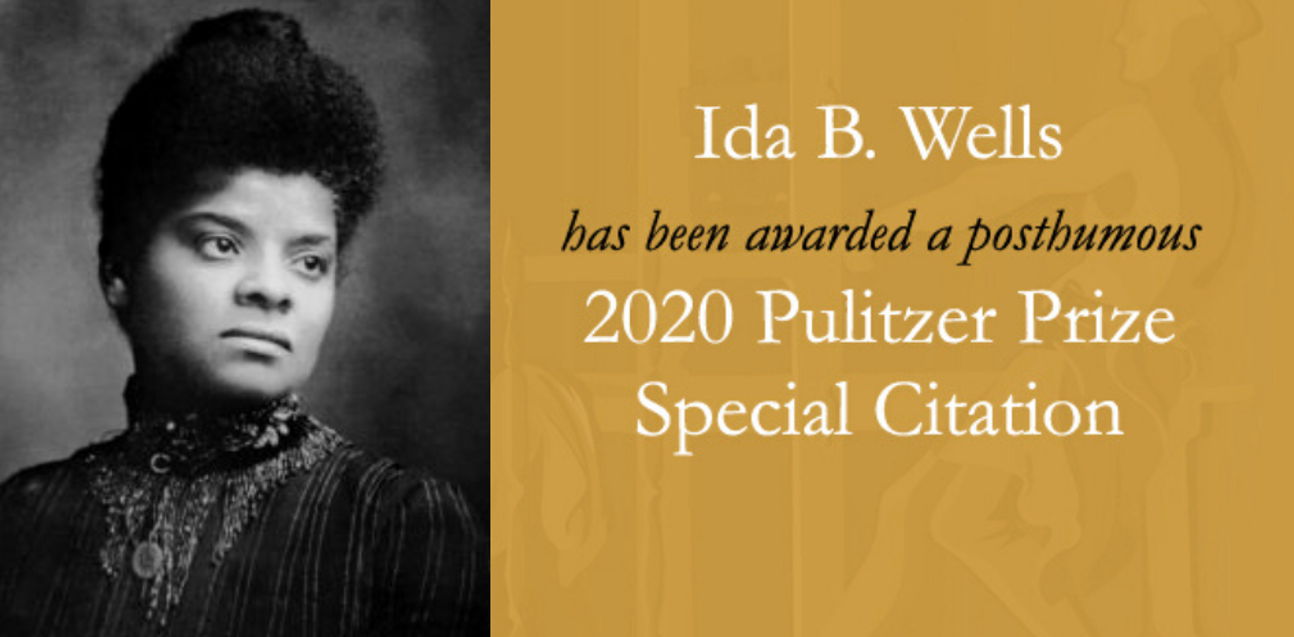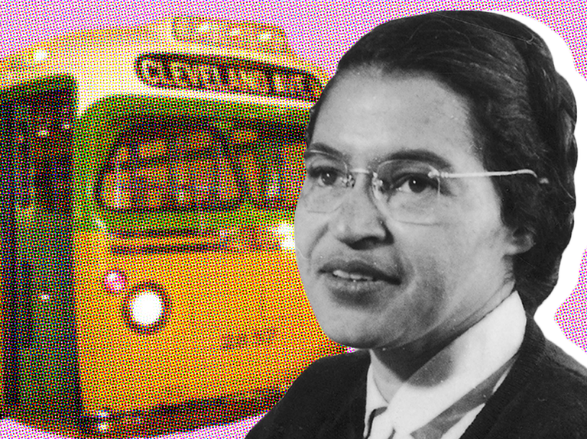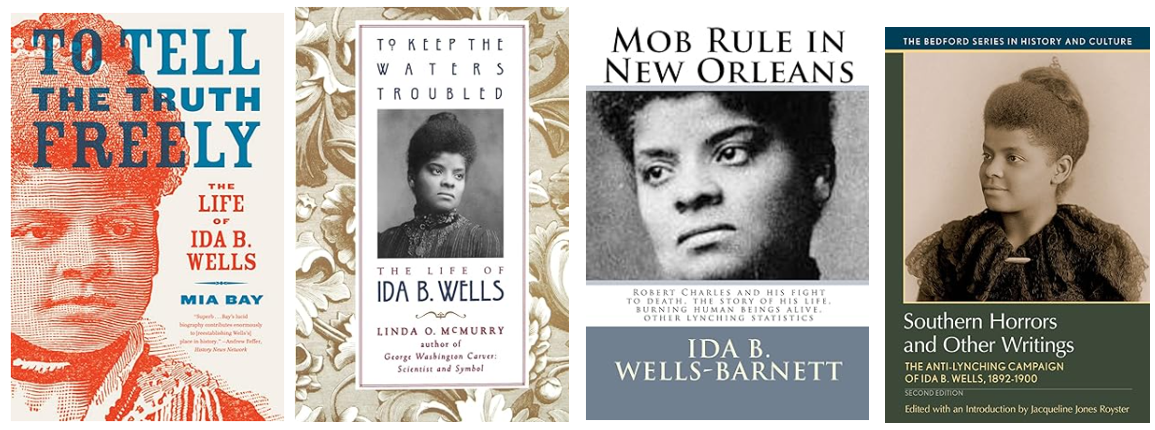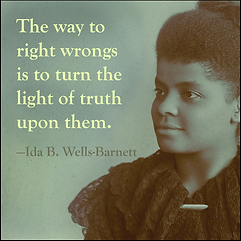 By Neenah Payne
By Neenah Payne
As more people lose faith in corporate media, citizen journalists are increasingly taking the lead. Now that almost everyone has a cellphone, people everywhere can document a wide variety of events and report on them quickly and easily through social media or websites. They can also share their thoughts on many good alt media sites like Activist Post.
This article looks at the amazing story of Ida B. Wells-Barnett (1862-1931), the first citizen journalist.
Before Rosa Parks, There Was Ida B. Wells
Most Americans know about the historical refusal of Rosa Parks (1913-2005) to give up her bus seat to a White man in Montgomery, Alabama in 1955. That sparked a bus boycott that got the nation’s attention. The boycott eventually fueled the Civil Rights Movement (1954-19640 led by Dr. Martin Luther King Jr which changed America. It is described as “the greatest mass movement in modern American history”.
See Rosa Parks Was My Aunt. It’s Time to Set the Record Straight
However, some 80 years before Rosa Parks refused to move to the back of a bus in Montgomery, Alabama, 22-year-old Ida B. Wells refused to move out of her train seat. Later, when three of her friends were lynched because their grocery store outperformed a nearby grocery store owned by Whites, Wells began to write and became the first “citizen journalist”.
Arizona State University’s Walter Cronkite School of Journalism and Mass Communication created the Ida B. Wells Professor in Journalism to honor Wells .She was an African American investigative journalist, educator, and early leader in the civil rights movement.
Life Story: Ida B. Wells-Barnett (1862-1931)
Wells’ Great Grandson
Ida B Wells: The Story of America’s First Black Female Investigative Journalist 7/16/17
In part one of our series celebrating her 155th birthday, the great grandson of Wells tells the story of how the pioneering reporter risked her life to report on lynchings and racism during the tumultuous period of Reconstruction.
Ida B. Wells: A Chicago Stories Special Documentary
There are few Chicago historical figures whose life and work speak to the current moment more than Ida B. Wells, the 19th century investigative journalist, civil rights leader, and passionate suffragist. WTTW brings you a new CHICAGO STORIES special that tells her story as never before. Freed from slavery just six months after she was born, Ida B. Wells once described her childhood with her parents and siblings in Holly Springs, Mississippi as “happy.” But a tragedy would alter the course of Wells’ youth.
As a young woman and teacher, she refused to give up her seat on a train car that she was told was reserved white women. That incident launched the young Wells into her first public fight for justice. Through writing, Ida B. Wells found her “real” self. As she put pen to paper, her words became an important tool to analyze, debate, and persuade readers on the issues of the day, particularly when it came to race and gender. But after the lynching of her close friend in Memphis, Wells found a new kind of power in her pen.
Learn much more at https://www.wttw.com/idabwells.
Ida B. Wells: Citizen Journalist
Giving credit where it’s due: The value of citizen journalism in the U.S. media landscape
To know the value of citizen journalism is to know the story of Ida B. Wells and how her work still influences the citizen journalists of our time
Ida B. Wells was a citizen journalist
Wells started as a teacher, then became a member of a local literary club in Memphis and began writing about developments impacting the local Black community. Her columns were featured in Black newspapers across the country including the New York Age, Detroit Plaindealer, and the Chattanooga Justice.
In 1889, she became co-owner and editor of the Memphis Free Speech and Headlight where she continued to write about issues of race and gender discrimination. Her editorials criticized Memphis’ segregated school system and subsequently, she lost her teaching job. This change in circumstance further stoked her activism and pushed Wells to embark on a new career in journalism.
In 1892, her close friend, Thomas Moss, and two associates were murdered after the grocery store they opened began to compete with the business of a white-owned shop across the street. She channeled her outrage and grief into incisive prose about Jim Crow laws and sanctioned lynchings that terrorized Black communities in the South. And she challenged the myth of lynchings as justifiable punishment for crimes committed by Black men and women. It was not long before the paper was shuttered and Wells and her partner were driven out of Memphis.
These injustices would be the catalyst for Wells’ greatest contributions to journalism: She began to research and document the lynching of Black people in the South, writing “Southern Horrors: Lynch Law in All Its Phases” in 1892. The pamphlet established Wells as the forebearer of the anti-lynching movement in the United States. And her work, “A Red Record,” which analyzed nationwide press coverage and statistics of lynchings since the end of the Reconstruction Era, stands as a then-unprecedented example of longform and data-driven reporting in the U.S.
Yes, Wells’ work is rooted in protest and civil rights advocacy. No, she never received any formal education on how to be a reporter. Nonetheless, her meticulous journalism positioned Wells among the earliest and more celebrated Black journalists — journalists, period — in U.S. history. Wells was a pioneer of data investigation long before this discipline formally existed—and years before the hallowed institutions of journalism we know today were founded in this country.
Despite her seminal contributions, Ida B. Wells was called a liar and was discouraged by her contemporaries. For one, as a feminist and abolitionist, her writings were well-steeped in the communities she deeply identified with or called her own. And as a Black woman born into slavery and who had lived to see Emancipation, Reconstruction, and the backlash that followed in the Jim Crow South, many of the injustices she documented took place nearby or mirrored her own experiences.
Wells was subjected to a perceived lack of credibility among her peers. And this line of criticism, particularly because of a reporter’s proximity to a subject, is something community journalists continue to face to this day. It’s something that needs to change in order to support thriving, informed communities, and a more robust, inclusive press.
‘Fearless’ Ida B. Wells honored by new lynching museum for fighting racial terrorism
After Ida B. Wells published a column on May 21, 1892, denouncing “the old thread bare lie” that lynching was used to “protect white womanhood,” a white mob marched to her office in Memphis, destroyed her presses and left a warning they would kill Wells if she tried to publish her newspaper again. Wells, who was on a business trip to the East Coast at the time, did not flinch upon hearing of the threat.
“I had been warned repeatedly by my own people that something would happen if I did not cease harping on the lynching of three months before,” Wells wrote in her memoir, “Crusade for Justice: The Autobiography of Ida B. Wells.” “I had expected that happening to come when I was at home. I had bought a pistol the first thing after [my friend] Tom Moss was lynched, because I expected some cowardly retaliation from the lynchers.”
On Thursday, the National Memorial for Peace and Justice in Montgomery, Ala., became the first in the country dedicated to more than 4,000 lynching victims. It also honors Wells, along with other black women who risked their lives in the fight against racial terror.
The memorial, which includes more than 800 steel monuments bearing the names of thousands of lynching victims, contains a reflection space dedicated to Wells, who with her incisive investigations, detailed reporting and meticulous data revealed lynchings’ barbarism.
‘Lynch him!’: New lynching memorial confronts the nation’s brutal history of racial terrorism
“For more than 40 years, Ida B. Wells was one of the most fearless and one of the most respected women in the United States,” wrote historian John Hope Franklin in the foreword to her memoir. “Few defects in American society escaped her notice and her outrage. … She was perhaps the first person to recite the horrors of lynching in lurid detail.”
During her travels to England in the late 1890s, Ida B. Wells-Barnett, known by her maiden name Ida B. Wells, spoke to audiences about the horrors of lynching during an international crusade to shine light on the violence and racism of America. “She became nearly as well-known in England as she was in the United States,” Franklin wrote, “for she was determined that the entire world should know her native land for what it really was.”
Wells was born enslaved in July 16, 1862, in Holly Springs, Miss., during the Civil War, five months before President Lincoln issued the Emancipation Proclamation. Her mother, Elizabeth Wells, who had been sold from a plantation in Virginia to one farther south, taught her about maintaining dignity in the face of dehumanizing racial oppression. Her father, James Wells, was the son of a carpenter who was a slave owner. He was often described as a “race man,” advocating for the rights of newly freed black people and working with the Republican Party during Reconstruction….
One day in May 1884, Wells-Barnett was riding a train in Memphis when a white conductor on the Chesapeake and Ohio Railway ordered her to move to the segregated Jim Crow car, according to “Crusade for Justice.” Having bought a first-class ticket to ride in the ladies’ car, Wells refused.
The conductor grabbed Wells, trying to force her off the train.
“The moment he caught hold of my arm, I fastened my teeth in the back of his hand,” she wrote in her autobiography. “I had braced my feet against the seat in front and was holding to the back, and as he had already been badly bitten he didn’t try it again by himself. He went forward and got the baggage man and another man to help him, and of course they succeeded in dragging me out.”
She was thrown off the train, but she refused to bend to the injustice. She sued the railroad for forcing black people to ride in “separate but unequal coaches.” She won the case. In December 1884, a local court awarded her $500 in damages. Her lawsuit was celebrated across the country. But the railroad appealed, and three years later the Tennessee Supreme Court overturned the lower-court ruling.
The ruling left her with a profound disappointment in the justice system.
“I had hoped such great things from my suit for my people generally,” Wells wrote in her diary, which was published as “The Memphis Diary of Ida B. Wells: An Intimate Portrait of the Activist as a Young Woman.” “I have firmly believed all along that the law was on our side and would, when we appealed to it, give us justice. I feel shorn of that belief and utterly discouraged, and just now, if it were possible, would gather my race in my arms and fly away with them.”
Wells continued teaching in Memphis, trying to help black people obtain an education. And she began writing columns about her lawsuit. Her articles appeared in church newspapers and black weeklies.
Soon, she was offered a regular column in The Memphis Free Speech and Headlight, an African American newspaper in Memphis, where she used the money she had saved as a teacher to become a part owner, according to her memoir.
She wrote columns under the name “Iola.”
Her anti-lynching campaign would begin in full force five years later, after three of her friends — Thomas Moss, Calvin McDowell and Henry Stewart — opened a grocery in direct competition with a white-owned store in Memphis, according to an Equal Justice Initiative report. The men were arrested and killed by a white mob. Devastated and outraged by the murders, Wells began her own investigation.
“Like most other Americans, she believed that lynching victims committed crimes, especially rape,” according to the “Historical Scholars” section of “African American Criminological Thought,” published by the State University of New York Press. “However, the three blacks lynched in Memphis had not committed such crimes. Rather they were victims of a scheme by a white grocer in the vicinity who was losing business to them.”
Wells came to the conclusion that many of the rape stories were false, prompting her to write the now-famous editorial published May 21, 1892: “Nobody in this section of the country believes the old thread bare lie that Negro men rape white women.” The Daily Commercial newspaper in Memphis responded with an editorial, according to the University of Chicago Library collection of Well’s papers:
“The fact that a black scoundrel is allowed to live and utter such loathsome and repulsive calumnies is a volume of evidence to the wonderful patience of Southern whites.”
Wells responded by urging black people to get out of Memphis: “The city of Memphis has demonstrated that neither character nor standing avails the Negro if he dares to protect himself against the white man or become his rival,” she wrote in an editorial, according to “The Selected Works of Ida B. Wells-Barnett.”
She argued that the city “will neither protect our lives and property, nor give us a fair trial in the courts, but takes us out and murders us in cold blood.” “For nearly three months, black people left Memphis ‘by the scores and hundreds,’ supported financially by Wells and others who remained in town,” according to an essay in the book. “This continued until the white citizenry, feeling the loss of manual labor and business income, appealed to Wells to halt the exodus. She refused.”
In 1893 and 1894, Wells traveled to Europe, where she lectured about the horrors of lynchings occurring in the United States. Two years later, in 1895, she published “The Red Record: Tabulated Statistics and Alleged Causes of Lynching in the United States,” according to the Special Collections Research Center at the University of Chicago Library. “The southern white man would not consider that the Negro had any right which a white man was bound to respect,” she wrote.
In 1895, Wells married Ferdinand L. Barnett, the editor of the Chicago Conservator, one of Chicago’s first major African American newspapers. She became stepmother of his two children, and the couple had four more together.
In Chicago, Wells-Barnett became prominent in civic and political circles. She was one of the founders of the National Association for the Advancement of Colored People and led the fight to elect Chicago’s first black alderman and congressman, Oscar DePriest. And in 1930, she ran an unsuccessful campaign for state senator in Illinois.
‘Night of terror’: The suffragists who were beaten and tortured for seeking the vote
She also helped integrate the U.S. suffrage movement “when she refused to walk with the other black women at the rear of a 1913 Washington parade and instead infiltrated the ranks of her white Illinois ‘peers’ after the march began,” according to a National Park Service account of her life
Wells’s anti-lynching crusade for black justice continued until she died of kidney disease on March 25, 1931. She was 68. Eighty-seven years later, the Peace and Justice Memorial in Alabama builds on the work of Wells. The memorial is designed to prompt a national conversation about racial injustice, exposing the awful history of lynching with hundreds of steel monuments that literally sway in the wind, beaten by the elements and the sunlight.
“The way to right wrongs,” Wells once wrote, “is to turn the light of truth upon them.”
Clarification: An earlier version of this report referred to “Historical Scholars” as a book; it is a section of the book “African American Criminological Thought.”
Books:
To Keep the Waters Troubled: The Life of Ida B. Wells
Southern Horrors and Other Writings: The Anti-Lynching Campaign of Ida B. Wells, 1892-1900
Amazon Descriptions
Born to slaves in 1862, Ida B. Wells became a fearless antilynching crusader, women’s rights advocate, and journalist. Wells’s refusal to accept any compromise on racial inequality caused her to be labeled a “dangerous radical” in her day but made her a model for later civil rights activists as well as a powerful witness to the troubled racial politics of her era.
Though she eventually helped found the NAACP in 1910, she would not remain a member for long, as she rejected not only Booker T. Washington’s accommodationism but also the moderating influence of white reformers within the early NAACP. In the richly illustrated To Tell the Truth Freely, the historian Mia Bay vividly captures Wells’s legacy and life, from her childhood in Mississippi to her early career in late-nineteenth-century Memphis and her later life in Progressive-era Chicago.
In the generation that followed Frederick Douglass, no African American was more prominent, or more outspoken, than Ida B. Wells. Seriously considered as a rival to W.E.B. Du Bois and Booker T. Washington for race leadership, Wells’ career began amidst controversy when she sued a Tennessee railroad company for ousting her from a first class car, a legal battle which launched her lifelong commitment to journalism and activism.
In the 1890s, Wells focused her eloquence on the horrors of lynching, exposing it as a widespread form of racial terrorism. Backing strong words with strong actions, she lectured in the States and abroad, arranged legal representation for black prisoners, hired investigators, founded anti-lynching leagues, sought recourse from Congress, and more.
Wells was an equally forceful advocate for women’s rights, but parted ways with feminist allies who would subordinate racial justice to their cause. Using diary entries, letters, and published writings, McMurry illuminates Wells’s fiery personality, and the uncompromising approach that sometimes lost her friendships even as it won great victories. To Keep the Waters Troubled is an unforgettable account of a remarkable woman and the times she helped to change.
Wells’ Great Granddaughter
How Ida B. Wells Paved The Way For Citizen Journalists Today

Educator and writer Michelle Duster (at left) writes extensively about the life and legacy of her great-grandmother, Ida B. Wells.
Contemporary citizen journalists can find common ground with a trailblazer who was active during the late 19th and early 20th centuries: Ida B. Wells. Motivated by false narratives and the downplaying of abuse of Black Americans in her own day, Wells chronicled the stories of those impacted by lynchings and riots.
One of the narratives she deconstructed was the inaccurate idea that lynchings were only carried out on Black men accused of raping white women. Wells’ data proved that it wasn’t limited to that at all — and that Black men were also frequently the victims of false accusations. Wells’ quantitative work pioneered the way for data journalism and inspired her great-granddaughter Michelle Duster to dedicate her life to continue countering false narratives.
Duster is an educator and writer who has written extensively about her great-grandmother’s journey. Duster joined Friday’s St. Louis on the Air to talk about how Wells’ life and legacy have relevance today, in a media context where stories are still told through an overwhelmingly white male lens.
A Conversation with Michelle Duster: Ida B. Wells and Today’s Street Journalism
Chicago World’s Fair 1893
During slavery, it was a felony to teach a Black person to read and write. Anyone who tried to learn risked losing a finger for each attempt! Yet, as the video below shows, shortly after emancipation, there were many Black doctors and professionals in other fields. Wells wanted that remarkable success to be reflected in the Chicago World’s Fair of 1893.
Ida B. Wells: A Chicago Stories Special Documentary
Neenah Payne writes for Activist Post
Become a Patron!
Or support us at SubscribeStar
Donate cryptocurrency HERE
Subscribe to Activist Post for truth, peace, and freedom news. Follow us on SoMee, Telegram, HIVE, Minds, MeWe, Twitter – X, Gab, and What Really Happened.
Provide, Protect and Profit from what’s coming! Get a free issue of Counter Markets today.





Be the first to comment on "The First Citizen Journalist: Ida B. Wells"